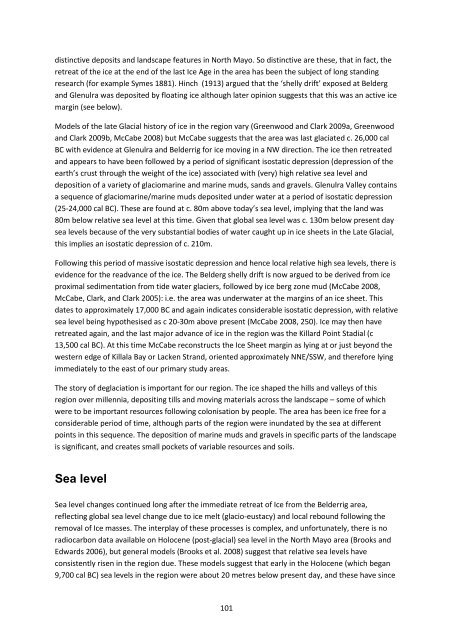Neolithic and Bronze Age Landscapes of North Mayo: Report 2011
Neolithic and Bronze Age Landscapes of North Mayo: Report 2011
Neolithic and Bronze Age Landscapes of North Mayo: Report 2011
Create successful ePaper yourself
Turn your PDF publications into a flip-book with our unique Google optimized e-Paper software.
distinctive deposits <strong>and</strong> l<strong>and</strong>scape features in <strong>North</strong> <strong>Mayo</strong>. So distinctive are these, that in fact, the<br />
retreat <strong>of</strong> the ice at the end <strong>of</strong> the last Ice <strong>Age</strong> in the area has been the subject <strong>of</strong> long st<strong>and</strong>ing<br />
research (for example Symes 1881). Hinch (1913) argued that the ‘shelly drift’ exposed at Belderg<br />
<strong>and</strong> Glenulra was deposited by floating ice although later opinion suggests that this was an active ice<br />
margin (see below).<br />
Models <strong>of</strong> the late Glacial history <strong>of</strong> ice in the region vary (Greenwood <strong>and</strong> Clark 2009a, Greenwood<br />
<strong>and</strong> Clark 2009b, McCabe 2008) but McCabe suggests that the area was last glaciated c. 26,000 cal<br />
BC with evidence at Glenulra <strong>and</strong> Belderrig for ice moving in a NW direction. The ice then retreated<br />
<strong>and</strong> appears to have been followed by a period <strong>of</strong> significant isostatic depression (depression <strong>of</strong> the<br />
earth’s crust through the weight <strong>of</strong> the ice) associated with (very) high relative sea level <strong>and</strong><br />
deposition <strong>of</strong> a variety <strong>of</strong> glaciomarine <strong>and</strong> marine muds, s<strong>and</strong>s <strong>and</strong> gravels. Glenulra Valley contains<br />
a sequence <strong>of</strong> glaciomarine/marine muds deposited under water at a period <strong>of</strong> isostatic depression<br />
(25-24,000 cal BC). These are found at c. 80m above today’s sea level, implying that the l<strong>and</strong> was<br />
80m below relative sea level at this time. Given that global sea level was c. 130m below present day<br />
sea levels because <strong>of</strong> the very substantial bodies <strong>of</strong> water caught up in ice sheets in the Late Glacial,<br />
this implies an isostatic depression <strong>of</strong> c. 210m.<br />
Following this period <strong>of</strong> massive isostatic depression <strong>and</strong> hence local relative high sea levels, there is<br />
evidence for the readvance <strong>of</strong> the ice. The Belderg shelly drift is now argued to be derived from ice<br />
proximal sedimentation from tide water glaciers, followed by ice berg zone mud (McCabe 2008,<br />
McCabe, Clark, <strong>and</strong> Clark 2005): i.e. the area was underwater at the margins <strong>of</strong> an ice sheet. This<br />
dates to approximately 17,000 BC <strong>and</strong> again indicates considerable isostatic depression, with relative<br />
sea level being hypothesised as c 20-30m above present (McCabe 2008, 250). Ice may then have<br />
retreated again, <strong>and</strong> the last major advance <strong>of</strong> ice in the region was the Killard Point Stadial (c<br />
13,500 cal BC). At this time McCabe reconstructs the Ice Sheet margin as lying at or just beyond the<br />
western edge <strong>of</strong> Killala Bay or Lacken Str<strong>and</strong>, oriented approximately NNE/SSW, <strong>and</strong> therefore lying<br />
immediately to the east <strong>of</strong> our primary study areas.<br />
The story <strong>of</strong> deglaciation is important for our region. The ice shaped the hills <strong>and</strong> valleys <strong>of</strong> this<br />
region over millennia, depositing tills <strong>and</strong> moving materials across the l<strong>and</strong>scape – some <strong>of</strong> which<br />
were to be important resources following colonisation by people. The area has been ice free for a<br />
considerable period <strong>of</strong> time, although parts <strong>of</strong> the region were inundated by the sea at different<br />
points in this sequence. The deposition <strong>of</strong> marine muds <strong>and</strong> gravels in specific parts <strong>of</strong> the l<strong>and</strong>scape<br />
is significant, <strong>and</strong> creates small pockets <strong>of</strong> variable resources <strong>and</strong> soils.<br />
Sea level<br />
Sea level changes continued long after the immediate retreat <strong>of</strong> Ice from the Belderrig area,<br />
reflecting global sea level change due to ice melt (glacio-eustacy) <strong>and</strong> local rebound following the<br />
removal <strong>of</strong> Ice masses. The interplay <strong>of</strong> these processes is complex, <strong>and</strong> unfortunately, there is no<br />
radiocarbon data available on Holocene (post-glacial) sea level in the <strong>North</strong> <strong>Mayo</strong> area (Brooks <strong>and</strong><br />
Edwards 2006), but general models (Brooks et al. 2008) suggest that relative sea levels have<br />
consistently risen in the region due. These models suggest that early in the Holocene (which began<br />
9,700 cal BC) sea levels in the region were about 20 metres below present day, <strong>and</strong> these have since<br />
101

















